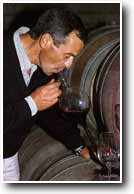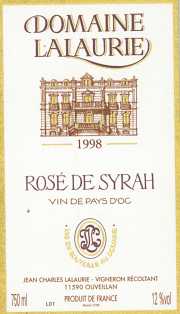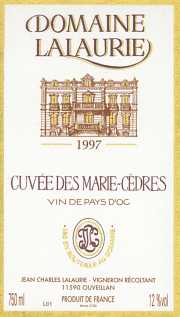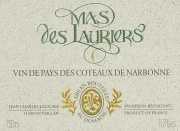| The Grape | Cabernet-Sauvignon is the grape variety used in many prestigious wines, producing a characterful wine hallmarket by its superb subtlety of aroma.
|
| Soil | Firm, chalky-clay earth. On this estate, Cabernet Sauvignon yields 50 hl/ha.
|
| Vinification | Grapes are picked using mechanical harvesters, thus faciliting picking at precisely the correct time. The level of maturity and natural acidity in the berries is of crucial importance in determining the style of wine produced. Vinification is carried out at a strickly controlled temperature in order to preserve the aroma and balance of the wine.
|
| Wine tasting | This ageing produces a deep, garnet-coloured red wine. Fruits of the forest such as blackberries and blackcurrant, are evident in the bouquet.
On the palate, the wine is well-structured and fullbodied with a pleasant chewiness.
The wine is young, supple and has an obvious tannic presence.
These tanning (your garanty of a well-made-wine) are concentrated but also round and flavoursome.
|
| Serving instructions | Decant into coldish jug and serve at about 18 degrees centigrade.
The Cabernet Sauvignon goes well with all meats and sauces, particulary with game.
|
| The Grape | Merlot is the stuff of fine wines ! Its distinctive smell is very characteristic and its marvellous bouquet comes from its oak-barrel ageing.
|
| Yield | On our estate, Merlot yields about 60 hl/ha.
|
| Soil | The soil is a coarse mixture of chalk and clay with small round pebbles and some gravel.
|
| Vinification | The grape ripens early in our district and is harvested at the start of September or sometimes at the end of August, if it has been a hot month.
The fermentation is traditionally carried out at a constant temperature, with a long maceration process in order to extract the tannins.
This garantees a good length on the palate.
After filtration, the wine is put into new oak barrels for the maturation.
|
| Wine tasting | The colour is a dark garnet red and the wine has strong "legs". The nose is graced with overtones of vanilla, rich in the aromas of forest fruits and spices. The palate is in complete and utter harmony with the nose, the fruits of the forest follow trough in the mouth. The wine has good length and a lovely oaky taste and elegant, velvety-smooth and to be savoured.
|
| Serving instructions | Uncork a little while before serving.
Serve at a temperature of about 18 degrees centigrade.
A good accompaniment to red meat and cheese.
|
| The Grape | This wine is made wholly from the noble Syrah grapes.
|
| Yield | The small yield (only 35hl/ha from poor soil) gives distinctively concentred flavours to the wine and account for its wealth of aroma and taste.
|
| Soil | The grape is grown on chalky hillsides.
|
| Vinification | The Rosť is "bled"; only the free-run juice from the first pressing of the grapes, goes to make this wine. Later, it is filtered at a cold temperature (about 10 degrees centigrades) and in this way, all fine particles are taken out of the must.
Only when this has been done, is the fermentation which allowed to take place. It will last for 18 to 21 days, at a relatively low temperature of 16 degrees centigrade, in order to preserve the natural aromas of the grape.
|
| Wine tasting | This is a light and youthful-looking wine with the hue of shining rose petals.
On the nose, the strawberries are prominent and sustained and developed further on the palate; one feels that one is drinking a fine wine of great delicacy. Well-balanced acidity levels demonstrate the vigour in this sprightly wine.
|
| Serving instructions | Although ideally a summer wine, the Syrah Rosť can be drunk througout the year and it is a delicious accompaniment for most meals.
Not designed to be layed down for a long time drink and serve chilled at 10 to 12 degrees centigrade.
|
| The Grape | This wine is made from different grape varieties :
Syrah 60%, Merlot 30%, Cabernet Sauvignon 10%.
|
| Yield | Average yield of 60 hl/ha.
|
| Soil | This grape is grown on chalky hillsides. Gravelly soil.
|
| Vinification | The different grape varieties are separately made by traditional way, with a short vatting time. The grapes are destemed and the temperature is regulated. The "Marie-Cèdres" cuvée is made from the wine of all these different grape varieties.
|
| Wine tasting | The colour is a dark garnet red and the wine has strong "legs". Fruits of the forest such as blackberries and cherries with a bite of leather and spices are evident in the bouquet.
On the palate, the wine is very fruity with soft tannin of choice berries; this wine is also rounded, unctuous with ripe fruits and a bit peppered.
|
| Serving instructions | A delicious accompaniment for all different dishes.
|
| The Grape | This wine is made from different traditional
grape-varieties : Syrah 25%, Merlot 10%, Cabernet-Sauvignon 50%, black Grenache & Cinsault 15%.
|
| Yield | Average yield of 60 hl/ha.
|
| Soil | This grape is grown on chalky hillsides. Gravelly soil and chalky-clay earth.
|
| Vinification | Mechanical harvest. The grapes are destemed before being put in vat.
(only the grape berries are put in vat for fermentation) The vinification is separately carried out at a strickly controlled temperature in order to preserve the aroma and balance of the wine.
|
| Wine tasting | The colour is a dark garnet red and the wine has strong "legs". Fruits of the forest such as blackberries and cherry are evident in the bouquet.
On the palate, this wine is very fruity with soft tannin of choice berries; this wine is also rounded and unctuous with ripe fruits.
|
| Serving instructions | A delicious accompaniment for all different dishes. You can serve it fresh.
|
| The Grape | This wine is made from Grenache (40%), Cinsault (40%), Syrah (20%).
|
| Yield | Average yield of 60hl/ha.
|
| Soil | This grape is grown on gravelly soil and chalky-clay earth.
|
| Vinification | Rose is "bled", only the free-run juice from the first pressing of the grapes, goes to make this wine. Later, it is filtered at a cold temperature (about 10 degrees centigrade) and in this way, all fine particles are taken out of the must. Then, the fermentation can start. It will last for 18 to 21 days, at a relatively low temperature of 16 degrees centigrade, in order to preserve the natural aromas of the grape.
|
| Wine tasting | This is a light and youthful-looking wine with the hue of shining rose petals.
On the nose, an aroma of fruits sustained and developed further on the palate; one feels that one is drinking a fine wine of great delicacy.
This wine is also unctuous and well-balanced.
|
| Serving instructions | This wine can be drunk throughout the year and is a delicious accompaniment for most meals. Serve chilled at 10 to 12 degrees centigrade.
|
| The Grape | This wine is l00% made from White Sauvignon.
|
| Yield | Average yield of 60 hl/ha.
|
| Soil | This grape is grown on chalky-clay earth.
|
| Vinification | Pressing of the grapes occurs directly after the harvest. There then follows 25 hours of cold precipitation during which time all particles in suspension are fined. Only at this point is the fermentation allowed to begin. It will last for 18 to 21 days with strict temperature control in order to protect the natural grapery aromas.
|
| Wine tasting | The wine is lively yellow tinged with hints of gold. There is a real intensity of fruits on the nose, a mixture of pineapple and passion fruits which make you feel the taste of exotic fruits cocktail with an excellent length.
The wine is illustrative of an excellent balance between acidity and alcohol.
|
| Serving instructions | Although ideally a summer wine, this wine can be drunk throughout the year and is a delicious accompaniment for most meals.
Serve chilled at 10 to 12 degrees centigrade. Excellent with fish, shellfishes and also with goat cheese.
|

 The wines of
The wines of






